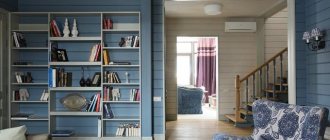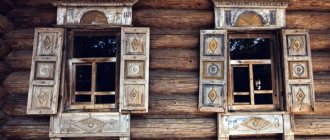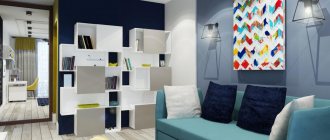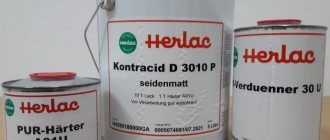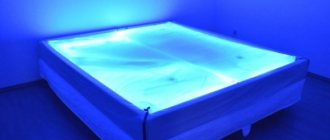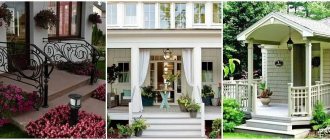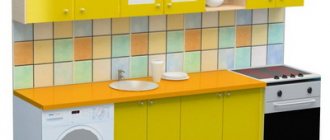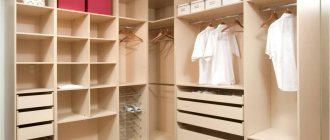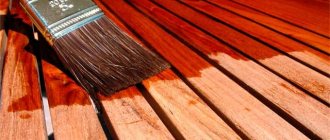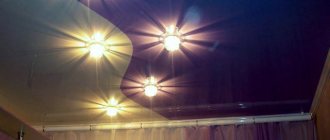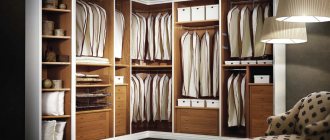An increasing number of homeowners, when choosing a finishing coating for interior walls, give preference to a natural material - wood. This choice is not surprising, because wood combines many useful properties: environmental friendliness, health benefits, beautiful appearance. These qualities are complemented by excellent performance characteristics: low weight, good sound and heat insulation. The simplest and most affordable wooden finishing material is considered to be lining, a thin cladding panel with a tongue-and-groove joint. Painting the lining inside the house is a necessary stage in the finishing of the home, allowing you to give the interior a complete look and solve several additional problems.
Lining in the interior: stylish living room of a country house Source de.decoratex.biz
Types of lining
Thin planed boards for surface cladding are made from various materials. The most popular and durable is deciduous and coniferous wood. Plastic and MDF are also used. There are two main types of lining on the market - classic and euro. They can be distinguished by visual inspection. Depending on the required profile shape, thickness, structure, you can select a tongue and groove board from numerous subtypes. The most popular varieties are:
- "Calm". A brushed board does not have a chamfer near the tenon. When installed between the profiles, the connecting seams are invisible. The boards are thick and create an imitation of timber. Can be used for cladding facades;
- Classic. The face of a flat board has an additional round or angular chamfer. Thanks to this feature, clearly visible seams are formed during cladding;
- Block house. The front part is completely rounded. After assembly, it seems as if the walls were assembled from rounded logs. Used in saunas and baths;
- Lound House. The surface is smooth with a complex pattern. The effect is achieved through additional processing (hot stamping, milling);
- American. Simulates siding panels. The cone-shaped lamella has a chamfer at the tenon. Used for interior decoration;
- Double-sided. Has two working sides. Due to its small thickness, it is recommended to use only for indoor partitions. There are no compensation channels;
According to the processing method, wooden lining is divided into grades - “extra”, “A”, “B”, “C”. You can distinguish them visually. The slightest knots and cracks are unacceptable on the front side of the premium class board. Class “A” accepts wood without rot, blue stains, or resin pockets. Light healthy knots are possible. In grade "B" resin pockets are allowed. The cheapest grade “C” allows for blueness and wane on the back.
Preparing for painting
Before covering the lining with varnish or acrylic, it should be cleaned of dirt and degreased with an alkali-based solution, and then sanded with a flat pumice stone or a grinding wheel. This will require the following tools:
- sponge and brush to remove dirt from the surface;
- roller, brush or spray for applying restoring and brightening agents.
This operation leads to the loss of all the protective characteristics of the wood. To restore them, treatment with a disinfectant composition is necessary. It will not only protect the wood, but also improve the quality of the varnish coating.
How to paint lining correctly
Using regular oil paint to renew the surface gives it an artificial shine and hides the natural grain of the wood. In addition, such coating is short-lived and will soon require modernization. When using acrylic varnish on wood panels:
- the original pattern is preserved;
- ensures attractive appearance;
- creates lasting protection from moisture and weather changes;
- the service life of the cladding is extended (up to 8-10 years).
Depending on the degree of darkening, you can use the concentration of the solution as prepared or dilute it with water in a 1:1 ratio. To avoid differences in the tone of the coating, it is necessary to apply a test stroke in an inconspicuous place. After this, the paint color is selected.
The recovery procedure consists of step-by-step operations:
- surface cleaning;
- drying wood;
- antiseptic treatment;
- testing and selection of shade;
- applying acrylic paint.
The final finishing with clapboard is quite often used in the repair of balconies and cottages. In order for the cladding to maintain a beautiful natural appearance for a long time, you need to follow the rules for using wood material and know how to lighten it. To ensure high-quality restoration of darkened panels, you should choose the right bleaching method. For this purpose, it is advisable to consult with specialists or read the instructions.
Advantages and disadvantages of painting lining
Painting the lining with enamel or colorless varnish can extend the life of the material. If the board is used for covering walls and work surfaces in a utility room, you can get by with regular impregnation. In a house or apartment, it is better to paint wood paneling with high-quality paint for practical and decorative purposes. After all, replacing a damaged top layer of wood is much more expensive than several cans of enamel. You can purchase a ready-made painted board or paint it yourself. Coating panels with your own hands has many advantages:
- Possibility of coloring elements in different colors, applying your own design, texture;
- Saving money. Treated lining is much more expensive;
- Possibility to choose the most incredible shade;
- Increasing resistance to negative external factors;
- Quick drying.
It is necessary to paint the lining before installation. During the normal drying process, there will be no light streaks at the joints that spoil the entire look.
There are practically no disadvantages to painting lining. The main negative point is the loss of the natural pattern and appearance of the wood. Some negative consequences can be avoided if you take into account the purpose of the room when choosing a paint and varnish material. Oil impregnation and drying oil are not suitable for baths and saunas. It is better to use solid mixtures with the addition of wax. It is not recommended to use flammable, toxic enamels for painting wooden boards in closed, unventilated areas. Painting lining floors should be carried out taking into account the abrasion of the material. To avoid having to repaint frequently, you should choose mixtures with high wear resistance.
Tips for choosing a topcoat and interesting ideas
A wide selection of coatings allows you to choose absolutely any color and texture for the lining. In a country house, it is better to give preference to the most durable and unpretentious compositions that do not have to be updated frequently.
If the finish is new, then it is worth preserving its natural color and choosing transparent products for processing: varnishes, azures.
If the panels have many defects or an old coating, then thick, opaque paint is indispensable. You can improve the appearance of the base surface by removing the top layer of wood, but this is too labor-intensive and time-consuming.
Unusual combination of paint shades for lining
The colors and shades of the lining can be combined in the decoration of one room. This technique allows you to divide a spacious room into zones. Decorate or diversify the design, place accents.
Color accents in clapboard finishing
Due to the color of the finish, you can achieve some visual effects. Light shades expand the space, dark shades, on the contrary, make it smaller. The white ceiling looks higher than the brown one.
The color scheme for the lining can match the palette of shades used in the interior or contrast.
Harmonious combination of color palette of textiles and walls
Solutions used for coloring
There are many means for covering lining. These are compositions for internal and external cladding of premises. They differ in composition, speed and quality characteristics. For example, a wooden exterior façade is affected by ultraviolet rays, moisture, high and low temperatures, so the finishing coating should contain the predominant majority of protective components.
You can decorate the lining of the interior of the house with ordinary enamels and paints. Painted natural boards have an original appearance. Each mixture after painting gives a certain effect to standard lining. The choice of solution depends on the preferences of the owner of a country or city building.
Protective agents: properties and application technology
Proper and timely use of protective equipment allows natural lining not to lose its appearance and original structure for many years. Antiseptic agents can increase the moisture resistance and durability of the material. The solutions also prevent damage by insects, various microorganisms, and the formation of mold, which is detrimental not only to the lining, but also to the health of the dacha owners. Based on the basis of manufacture, antiseptics are divided into four main groups:
- Organic solvents. They penetrate deep into the material, destroy areas of rot and mold, and prevent the appearance of new ones. Actively combat biological pollution. They have a pungent odor. Can be used indoors and outdoors;
- Water-soluble products. Temporarily protect wood in contact with moisture. Used for preventive purposes;
- Oil antiseptics. It is recommended to treat lining that is in the open air in contact with the ground with moisture. Effectively protect material in difficult conditions;
- Combined mixtures. The solutions contain various substances. Inherent in each group. They cope well with mold, moisture, and high temperatures. Can be used for both internal and external processing.
To reduce the negative impact on the lining, various solutions are used. Bioprotective compounds successfully fight pests, mold, and mildew. Fire retardants provide fire protection and slow down the spread of fire. Complex protective agents – biopyrenes – are used as a base coating. To bleach wood, you can use chlorine-containing mixtures, hydrogen peroxide, and special industrial liquids. Lining made from low grades of wood must be treated with primer to fill the pores.
The lining is covered with protective agents before varnishing and decorative treatment. The application technology consists of impregnating each fragment separately and on both sides. Using a brush or roller, spread the antiseptic over the entire surface in a thin layer. It is necessary to reach all hidden areas (corners, recesses). Wooden boards should dry without touching each other.
Varnish compositions and their properties
To refresh the antiseptic-impregnated lining and refine the finish, the wood is varnished. The required composition of the solution is selected based on the type and purpose of the room.
Oil-based resin varnishes can have different shades - from transparent to dark chocolate. The coating hardens quickly, forming a dense film. The moisture-resistant surface is easy to clean and is completely ready for further painting. The main disadvantage is the high level of fire hazard.
Alkyd universal solutions have a high level of resistance to external negative factors. They are absorbed deep into the wood, so they take a long time to dry (up to 3 days). Alkyd-urea varnishes have almost identical characteristics. Before use, the solution must be mixed with an acid hardener. It has a strong shine after hardening. Disadvantage: high price, rapid ignition.
Alcohol polishes and varnishes are used in minimal quantities to coat individual elements of the lining. Apply a very thin layer of solution using a cotton swab or small brush. The dried coating noticeably shines and gains elasticity. Some types of alcohol mixtures do not tolerate sunlight, so they cannot be used on large areas of the lining.
The composition of nitrocellulose varnishes includes plasticizers, resins, and pigment. After application to wood, they form a dense protective and decorative coating. They do not cover lining intended for finishing facades. Nitrovarnish does not tolerate sunlight. High temperature.
Water-based polyurethane and acrylic solutions are applied to the lining in several layers due to the high volatility of the mixture. They have surface tension properties and do not crack or wear off. The varnish adheres tightly to the wood, protects it from chemicals and getting wet.
Paints in different compositions for coating wooden lining
A wide variety of decorative mixtures allows you to choose the most extraordinary solutions to implement bold design ideas. With the help of paint and varnish products, you can give the lining absolutely any color and texture. The following paints can be used for interior decoration of a country house:
- Acrylate. Resistant to precipitation, retains shine and color for a long time. The paint has good adhesion and wears out slowly;
- Oily. It is well absorbed into the lining, does not allow moisture to pass through, and allows the material to breathe. May fade over time;
- Water-based. Preserves the wood texture and gives a matte finish. The paint dries quickly and has no odor;
- Silicone. Withstands impressive mechanical loads. It has good vapor permeability and masks defects. Retains color for 30 years;
- Alkyd-based enamel. Suitable for decorating lining. During prolonged drying, it emits a pungent, unpleasant odor. Fades quickly in the sun;
- Wax. Traditional, natural material for processing lining. After painting, it retains the natural pattern of wood, gives a matte, glossy shine;
- Silicate. The composition includes liquid glass, which significantly improves the characteristics of the paint. She is not afraid of ultraviolet rays. A dye with increased fire resistance protects the lining from temperature changes.
About the need to process the lining
Many people sincerely believe that walls covered with wood panels are beautiful in their natural appearance and do not require additional processing. Knowledgeable people have several reasonable objections to this; they indicate the need to protect sheathed walls from the following factors:
- Actions of ultraviolet radiation . If a wall covered with clapboard is regularly exposed to sunlight, over time the wood will darken and the walls in the room will begin to look different.
- Color changes . If the ventilation system in the house is poor, the air begins to stagnate. In places of high humidity, microorganisms develop and wooden lining may turn blue.
- Damage to the structure . In a room with excess humidity, wood easily harbors pests and mold; this causes rotting and destruction of the finishing layer.
- Mechanical damage . A layer of paint and varnish will absorb scratches and impacts and will not spoil the beauty of the walls.
- From fire . It is considered reasonable and prudent to protect wooden surfaces from the rapid spread of flame.
Unprotected lining is an easy target for destructive factors. Source drewinwest.com
Sometimes owners think about changing the interior. Lining can be easily updated - there are dozens of coating options and hundreds of shades that make it possible to make familiar rooms unrecognizable.
There is no clear answer to the question of how to paint wooden panels inside a country house. The choice is determined by the goals - whether the owners only want to protect wooden walls, refresh tarnished surfaces or radically change the color. Materials suitable for processing lining can be divided into two types: protective and decorative.
How to calculate the required amount of paint
Any repair or construction must begin with an estimate and detailed instructions. Consumables, such as paint for lining, must be purchased in reserve. When making calculations, one should take into account the characteristics of the surface, tools, professionalism of the work performers, the number of layers and the texture of the mixture.
If the entire room is to be painted, then first of all it is necessary to determine its perimeter. We take away the area of doors, windows, openings and other untreated surfaces. The result obtained must be compared with the standard consumption of the selected type of paint. Manufacturers place this information on the product label. You need to understand that the quantity is indicated taking into account the work under ideal conditions, for one layer of painting.
What do you need to know?
Features of painting wood inside the house, including in the country:
- The porous structure of the surface texture of the panels requires special treatment before applying paints and varnishes. If this is not done, there will most likely be uneven absorption and drying of the protective coating. This can ruin the appearance and quality of the wood.
- Due to the resins and oils in coniferous wood, any paint is not always suitable for processing. It is better to choose a composition that clogs the pores, creating a durable, solid, moisture-resistant layer and coating that prevents resins from escaping.
- If you do not coat the wood with a special primer, there is a risk of getting a coating that is uneven in structure. The film may even crack or darken after a short time. The desired decorative effect, which is described in the composition instructions, cannot be achieved.
- Sometimes standard panels require additional sanding. If the surface is perfectly flat, then the coloring materials will be evenly distributed and applied.
- Often one layer of coating does not give the desired effect. Either the color is too light, the finish is not shiny enough, or there are stains or other imperfections. Therefore, it is recommended to apply several layers, but only on a completely dry surface.
Attention
With full and careful adherence to the recommendations of the manufacturers of coloring compounds and proper preparation of the lining, the coating will be beautiful and truly protective.
Lining painting technology
Factory-painted lining elements cost several times more than untreated boards. The services of hired workers will also not be cheap. To save money, you can carry out all stages of coating yourself. Fortunately, this is not difficult to do. Properly selected consumables and auxiliary materials will enliven the interior and fill the house with new colors.
The application of enamel should be carried out after antiseptic procedures, priming and varnishing. When working with any mixture, certain rules must be followed. Only in this case can you count on a positive result.
Required materials and tools
Even a beginner can paint lining well. It's better to work with new material. It is quite simple to prepare, process and dry. The task becomes more difficult if the boards have already been used and the toning needs to be updated. Only clean lining can be repainted. The method of removing varnished coating is the same for all types of wood. It is better to bleach pine and larch in warm and ventilated areas. Painting wooden panels is carried out using a minimal set of tools and materials. You need to prepare:
- Paint tray;
- Galvanized, plastic bucket;
- Brushes for applying paint of different sizes, roller, spray gun;
- A ladder that allows you to reach the ceiling;
- Solutions for painting (stain, varnish, enamel, primer);
- Tools for stripping, grinding, rubbing (sandpaper, leather flaps, sanding machine and others);
- Wide safety glasses, mask, gloves.
What is better to paint
To apply paint to the lining, you can use a brush, spray gun or roller. Choosing the right tool will make the process much easier. For a small area, you can use a wide brush. In this case, the paint should be moderately thick so that there are no noticeable marks from the strokes. This material can be used to add color to both individual boards and the assembled structure.
It is better to use a roller for covering eurolining and other types of boards with a smooth surface, with unpronounced seams. You can take a wide tool that grabs two boards at once. This will speed up the process and reduce paint consumption.
When using a household spray gun, you must prepare for high consumption of water emulsion. In order for the paint to be better absorbed into the wood, the solution should be made very liquid. With this technology, leaks and layers are inevitable. It is necessary to strictly maintain the distance between injections to avoid the formation of drops.
Drying and moisture level of the lining
Only high-quality, dry wood can be used for cladding. Wet lining will certainly spread and crack some time after installation. You can determine the degree of humidity at home using the traditional method. The weight of a dry board is significantly different from a wet one. A mechanical pencil will not leave a purple streak on dry paneling. The sound of dry wood will be louder.
You can resort to traditional methods if you have comparative wet material at hand. If there is nothing to compare with, you can use a mechanical method of verification. It is necessary to drill a hole in the wood to be tested. Hold the cutter in one position for 20 seconds. Visual analysis of the excavation will indicate the approximate moisture content. The hole began to smoke - the board was overdried, nothing happened - the humidity was normal, a fringe formed - the lumber was damp. The lining must be dried under a canopy in the open air for several months.
It is necessary to thoroughly dry the lining after each treatment (impregnation, priming, varnishing, painting). If these are separate boards, they should be placed in a ventilated area or taken outside in warm weather until completely dry. The hardening time for each solution used is individually calculated by the manufacturer. The drying time may increase if the paint is applied in several layers.
Preparatory stages
Proper preparation of the lining for painting makes it easier to work with the material in the future. New dried boards should be cleaned of dirt. If it is very dusty, you can use a damp cloth and baking soda. Then it is necessary to eliminate all defects. The wood is sanded with pumice or fine sandpaper. Small particles are removed and primer is applied.
If the lining has already been used, preparatory work includes mandatory cleaning of the old coating. Paint and old varnish are removed with solvents. Multilayer dried materials are removed with a metal brush, hairdryer, or construction spatula.
If in the future the old lining will be covered with transparent varnish, then it is better to use a mechanical cleaning method. Solvents and removers can whiten the surface unevenly.
Applying paint
It is easier to paint wooden lining before its installation. The solution should be applied in a thin layer, slowly moving from top to bottom. If a brush is chosen for work, it should have semi-stiff bristles. To avoid streaks, do not put a lot of paint on the brush.
The roller should have medium-length pile. After dipping it in paint and rolling it along the tray, the tool is pressed against the paneling with moderate force and rolled several times. There should be no voids or smudges on the surface. If the boards have already been assembled, their edges must be painted with a brush. Painting with a spray gun will be faster, but some of the paint will scatter onto nearby objects.
Painting: features and nuances
Having chosen what to paint the wooden lining inside the house with, they begin the painting process. In order for the result to be of high quality and delight the owners for many years, the following preparatory work must be completed:
- Stock up on tools . You will need paint brushes and a tray, the chosen paint material, a roller with interchangeable attachments, a bucket, fine-grained sandpaper and protective gloves.
- Clean the surface . The lining is cleaned of dust, dirt, and old coating with a stiff brush or pumice stone, then treated with sandpaper.
- Degrease the wood . Treating the surface with an alkaline detergent will improve the adhesion (adhesion) of paint to wood.
- Carry out grinding . You can level the surface using pumice, sandpaper or sanding mesh. The defects are first filled with putty, and the resin is removed with a solvent.
Minimum set for painting wooden panels Source sovkalmykia.ru
- Pre-treat the lining . A primer is applied, and after it dries, an antiseptic impregnation is applied. The process can be accelerated if you purchase a combination composition that combines both products.
- Paint the walls . After waiting for the primer and antiseptic to dry, begin painting. Paint for lining inside the house is applied in two or three layers. The number of layers depends on the selected material and is indicated in the instructions. It is possible to paint wooden panels well before installing them on the walls, but this is not always possible (the procedure requires a large awning or canopy).
Painting with brushing of lining
A non-standard solution will give the wood an aged, aristocratic look. You can create this effect using a drill with a special attachment – a brushed ball. When processing the surface, depressions are formed, which, when painted, appear as an unusual pattern. Its depth can be adjusted by passing the ball.
You can use dark or light oils to paint the board. Apply the coating using the “dry brush” method using a thick sponge and rub evenly over the surface. The first layer dries for 2 hours. Then light oil or paint is applied. After 15 minutes, remove with a rubber spatula, pressing it well to the surface. After drying, the wood will get an interesting aged effect.
Carrying out the procedure
To paint wooden panels, paint or varnish with colors and dyes of different types and compositions is used (how to properly varnish a panel for a long time?). Application techniques and finishing methods depend on the composition of the paintwork material.
Varnish
To paint wooden panels with varnish you will need:
- check all existing lining, sort it by color and quality, exclude panels that contain falling knots or other obvious defects;
- thorough sanding is carried out until absolutely smooth to the touch is achieved;
- if necessary, cover with a special primer or apply the first base layer of varnish, leave each canvas to dry without touching the treated surface;
- if an opaque varnish is used, then repeated sanding over the painted layer is necessary;
- A second layer of varnish is applied until the color is uniform over the entire area of the canvas, and then dried.
Advice
Rejected panels can be used as test panels. On them you can see the type of coating with different numbers of layers, etc.
You can watch how to properly varnish the lining, what tools and techniques to use for this, in the following video:
Dyeing white
To create the desired decorative effect, several coloring techniques are available:
- Acrylic pigment primer diluted to 80-100% is applied like a regular varnish. It creates a coating with a long service life, but its price is high.
- Polyurethane pigment primer labeled “bleached” or “white” with a dilution of up to 80-100% also provides the desired decorative effect, but over time the color becomes yellow.
- Oil with wax - with a single-layer coating requires rubbing with a rag to preserve the wood texture; with a two-layer finish the surface is opaque.
- Tinting or staining - often found with the markings “bleached oak”, “frost” and the like. The peculiarity of the finishing is a multi-layer coating with very thin and uniform films. Otherwise, a peeling effect will form on the surface.
These methods provide different shades of white, depending most on the type of wood.
You can learn how to quickly and correctly paint the lining white from this video:
Technicians
For high-quality painting of lamellas, the following rules must be followed:
- Dry lining is processed only from the outside, and a wet panel must either be pre-dried or processed on all sides, including the ends. This is especially true for rooms with high humidity.
- The coating is applied to each plank separately to achieve an even color over the entire surface and to prevent the appearance of visible boundaries between strokes.
- When painting lining that is already installed on the wall, it is difficult to achieve maximum filling of the joints, so you need to choose a special brush.
- It is necessary to adhere to the technology recommended by experts for painting tongue-and-groove wooden lamellas.
Attention
If the quality of the first layer remains below average, then it needs to be sanded and primed again. Apply paint only to dry boards.
This approach will even out the density across the entire surface of the material to ensure a uniform shade.
Often they cover surfaces that are already installed on the wall. Therefore, the technology may differ slightly. You need to paint along the board, but with movement from one edge, for example, from one doorway to another. This will provide more even coverage as there will be no wet transitions.
Painting wood while maintaining texture
Painting the lining and maintaining the wood texture is very simple. For this purpose, varnish, pigmented oils and glazes are used. Work can be carried out on separate boards or already on a sheathed wall. Use a roller and several brushes of different sizes.
Texturing technology involves applying dispersion varnish with a brush to small fragments of material and then evenly distributing it. Use a roller for spreading. It is necessary to move strictly along natural furrows. After 10 minutes, remove excess mixture. The varnish remains in the grooves, making the design bright and shiny.
Varnished surface
Wood varnishes have a wide range of possible options.
This is a dense and thick material that is applied to the coating in two layers after previous drying. The advantage of painting is that the varnish also acts as a protective layer for the facing coating against moisture, dampness and fungus. Varnish coating of lining
Using varnish allows you to slightly change the shade of wood without disturbing its individual pattern. Also, in this way you can make the surface matte or add a glossy shine to it. Varnish is an inexpensive material and requires one to two days to dry. Also, the coloring does not have an unpleasant odor and will last the room for about ten years.
How to paint lining like bleached oak
You can achieve the effect of bleached oak and preserve the natural beauty of the tree using frost stain, white oak stain, transparent wax oil, polyurethane, or bleached acrylic pigment.
First of all, apply the tint in a thin layer. Then cover with oil. The thickness of application depends on the expected result. If you need a clearly defined pattern, remove the excess and wipe the surface with a rag. You can whiten wood using a primer. But it is worth considering that on some breeds it will turn yellow over time. For example, pine material can be whitened with regular gray wood paint.
How to properly prepare wood?
Before applying paint and varnish composition to wood, it must be prepared.
Drying the panel
On raw wood, the maximum service life of paint and varnish coatings rarely exceeds 2 years, and more often it is even less than 1 year. Therefore, the lamellas must be kept outdoors or indoors, the humidity of which is more than 15% for up to 30-40 days. It is advisable to avoid direct sunlight, which will lead to uneven drying.
Deep penetration antiseptics significantly speed up drying.
You can check the humidity level like this:
- cut a square of 0.4x0.4 m from polyethylene;
- wrap the panel and secure it tightly with tape;
- maintain in this state for a day in room conditions;
- measure the moisture content of polyethylene from the inside.
An oilcloth that is wet to the touch indicates that the panels have not dried sufficiently.
Processing of lamellas
If materials are category B, then they must be sanded. To do this, use a power tool or regular wood sandpaper. In this case, the last stage should be carried out with finishing fine-grained sandpaper. This is done to level the surface of the lining in the area of knots, various inclusions, and differences.
Tip You can process the wood after attaching it to the wall with a sander or an abrasive nylon brush.
here
Applying primer
The essence of treatment with this composition is the creation of a dense layer on the surface of the wood, which binds dust, eliminates small specks after sanding, and reduces the porosity of the material. Adhesion increases, and paints and varnishes gain stronger adhesion.
An additional advantage will be the fact that after such surface treatment, paint consumption is significantly reduced. Therefore, you can purchase more expensive and high-quality compounds.
The following types of wood primers are used:
- based on epoxy resin;
- based on silicone and acrylic;
- acrylic.
You only need to choose a special composition for interior decoration; for this you need to make sure that the packaging has the appropriate markings.
Aging effect
You can make the interior of a room attractive and original by artificially aging finishing materials. Natural lining without coating looks monotonous. You can add antique value to it in several ways:
- Brushing. Suitable for pine or oak. The top layer of the rock is removed with a coarse brush, sanded and covered with stain of any color, for example, wenge;
- Pantination. Use two colors of paint, slightly different shades. The first enamel is applied in a thick layer and allowed to dry. Then paint a thin layer of lighter paint. After complete drying, rub the surface with sandpaper. The illusion of numerous repainting of the lining is created;
- Paraffin treatment. Wax is applied unevenly to individual areas. Then the pantining process is repeated. After drying, remove it with a spatula and treat the board with stain. The result is a worn effect.
Choosing paint for a wooden facade
One mistake many homeowners make is not reading carefully, or not reading at all, what is written on the paint can. This information contains instructions and recommendations from the manufacturer, following which you can achieve the desired result. But before it comes to them, you need to decide on the type of paint. After this, you can begin to familiarize yourself with the nuances of its application.
It has been noticed that oil paints lose their color saturation the fastest. They become covered with cracks faster than others. The reason is the composition of these coatings and their viscosity. The latter property provides high covering ability, but does not guarantee the quality of the coating. Therefore, oil compositions are not often used for finishing facades.
Oil paint MA-15 “Economy”
The best choice for exterior work is quick-drying water-soluble acrylate paints. You can pay attention to the products. This manufacturer has a wide range of paints and varnishes for facade work. Excellent reviews of Ultra and Pika Techo paints.
"Pica-Techo" acrylate paint
Paint for wooden facades Tikkurila Pika-Techo
For regions with unstable climatic conditions, characterized by temperature changes and cold winters, silicone-based façade paints are suitable. These compositions successfully withstand low and high temperatures, have a high degree of moisture resistance, and at the same time remain vapor permeable. Silicone facade paint combines the best properties of acrylate and silicate compounds and forms a durable, uniform coating.
Facade silicone paint
Prices for different types of construction paints
Construction paint
Characteristics of facade coatings
| Type of paintwork | Working temperature | Drying time | Consumption |
| Acrylic | +5°С – +20°С | 12-24 hours | 115-120 g/m2 |
| Oily | +5°С – +20°С | At least 72 hours | 110-130 g/m2 |
| Alkyd | +5°С – +20°С | 24 hours | 140-150 g/m2 |
| Silicone | +5°С – +20°С | 24-48 hours | 150-180 g/m2 |
The lining can be painted with stains, tinting impregnations and oils. Wax or varnish is used as a finishing coat.
Samples of shades of applied stains
Wood stain, shades
Ideas for painting lining in the interior of an apartment/house
In the interior of city apartments, painted lining is practically never found. Natural material will take root well on loggias and balconies. The style solutions of country houses, on the contrary, will be complemented by a natural zest when using wooden profiles.
The combination of lining of different thicknesses looks unusual. A wide profile is alternated with a thin one and painted. They are painted in one color, but in different intensities. Depressions and waves are formed from smooth profiles and block houses. The lighting areas are whitened, the remaining areas are simply coated with clear varnish.
The bleached lining on the ceiling, located between dark massive beams, looks original. In the bedroom, living room, nursery, you can create an exclusive wall covering, paint the wood in any bright color, or paint it with patterns.
Choosing a color for painting the lining
Walls lined with clapboard are the backdrop for creating the interior of a country house, so choosing the appropriate shade is a task no less important than choosing the optimal paint and varnish composition. To ensure that the choice of color for wooden panels does not disturb the harmony of the design, the following rules are followed:
- For the walls, choose a shade that differs no more than a few tones from the color of the ceiling and floor. Contrasting transitions will harm the overall style (only if the interior is not designed in any of the avant-garde styles).
- White color is a classic way to expand a space and make it lighter. It adds elegance to the interior, goes well with other shades and hides surface defects well.
Warm colors are welcome in bedroom design Source bookdifferent.com
- In the design of the living room and kitchen light and warm shades look best : cream, peach, brown.
- The children's interior allows the use of bright colors (for which high-quality and safe acrylate paints are ideal). In the bedroom , walls lined with wood panels are varnished in natural shades or soothing colors - lilac, beige, honey. Gray-blue or brown-green colors are suitable for decorating the walls of the office
Ideas
In a modern interior it is very difficult to find a place for classic lining with a light fiber texture. Most often it will look like a tree trunk torn out of the forest and brought straight into the house. You need to choose a finishing method and create the desired decorative effect so that the interior looks as harmonious as possible (read more about where lining is used and how to sheathe walls inside and outside with it, and find out how to beautifully sheathe walls and ceilings with wooden boards in a separate material).
There are several interesting ideas for painting wooden panels:
- Alternate combination of different tones of coloring compositions, panels of various thicknesses and widths.
- Multi-profile panels can be combined into an interesting relief.
- The placement of spotlights in different areas of the cladding creates incredible lighting effects that significantly transform the appearance of the lining.
- The use of several colors of paints or varnishes in the same color range, but different in saturation and tone. This will allow you to emphasize some areas and zoning the space.
- Painting on a wooden surface looks very original and natural.
- Bleached canvases create a feeling of spaciousness and a more noble interior.
Important
It is important not to overdo it and not turn the room into a color blot. It is necessary to adhere to a harmonious combination of colors and their saturation.
Applying paint
To paint the lining, use a small or medium-sized paint brush and a spray gun (this device allows you to cover large areas in a short time, but is used only by professional builders). The first option is considered more popular when doing DIY painting due to the availability of tools. Work begins with painting hard-to-reach places. First, the composition is applied with a narrow brush, then with a wide one.
The dye is applied 2-3 times, allowing the solution to dry. Work on painting lining can be divided into several simple stages:
- thoroughly mixing the paint in the original container;
- pouring part of the dye into a small plastic container;
- dipping the brush into the composition for half the bristles;
- applying the painting tool to the panel, carefully moving along the surface along the boards.
All movements with the brush are performed in one direction, while it is necessary to slightly overlap the already painted areas. To process the finishing material at the joints, at the corner of the room, as well as in areas adjacent to window and door openings, use a narrow brush.
Each subsequent layer is applied after the previous one has dried. The last time the surface is covered from top to bottom with uniform light movements of the brush. When applying the finishing layer of aqualak, it is necessary to periodically stir the composition.
If you need to get a natural wood texture, you need to use wax, pigmented oil or glaze. Any of the compositions is applied along the entire length of the lining, then the strokes are shaded and the solution is left to soak in for 5-10 minutes. After the specified time, remove part of the dye with a lint-free cloth, which allows you to highlight the structure of the wood. A significant portion of the pigment remains in the grooves of the wood, while there is little dye in the protruding areas. At the final stage of work, after the layer has dried, the boards are coated with colorless varnish.
Required tools and materials
In addition to the impregnating composition itself, you need to prepare tools for application. This could be a spray gun or a set of brushes of different sizes. The product packaging provides detailed application instructions and recommended tools.
Also useful for work:
- construction tape;
- absorbent wipes;
- container for coloring product;
- sandpaper No. 240.
To coat the joint areas, it is better to prepare a separate small brush. To prevent lint from sticking to the surface, instruments should be periodically rinsed in a soapy solution. It is worth doing this before you start applying the product.
Useful tips
A few recommendations from experts will ensure stunning results with a decorative coating effect:
- Before application, mix paints and varnishes thoroughly until they have a uniform consistency and color.
- Test painting of a test board will protect the material from damage. Perhaps at this stage a decision will be made to choose a different color or tone of dye.
- Several thin coats will ensure even shine and color.
- For a more uniform shade of the coating, adding the same color to the primer as to the varnish or paint will allow you to obtain an ideal surface.
- You need to choose a slightly cloudy day so that the painted surfaces do not come into contact with direct sunlight.
- The ends need to be trimmed because they absorb moisture more strongly than the longitudinal fibers of the wood.
The choice of color for the lining is an individual matter. It is important to properly prepare wooden panels and paint them. Work performed in accordance with the techniques and recommendations provides the best decorative effect.
Selection of necessary materials
Oil-wax impregnations to match the color of any wood
The choice of product depends on the expectation of the final result. New wall decoration is treated with protective compounds to prevent fire, discoloration, and destruction. Paint and varnish compositions are used to change the color of walls, to hide the repair of cracks, chips, and knots.
There are preparations for a more vivid expression of the wood-fiber structure. Rosewood, larch, walnut, Karelian birch have an original pattern that needs to be preserved and enhanced. They use glaze, wax, pigmented drying oils, oils, and various varnishes. As a result, the fibrous pattern becomes brighter than in the raw form; a larger volume of pigment accumulates in the grooves of the texture, but not on the protruding parts. The technique is called texturing or brushing the lining. Wood painted this way looks attractive on the ceiling and vertical surfaces.
For humid operating conditions in unheated rooms, on verandas, terraces, treatment with agents to increase moisture resistance is required. Only after this is varnished, painted or decorated using certain techniques. Some types of wood require re-application of a preservative.
Protective compounds
Coating the lining with an antiseptic
Products are divided into impregnations for internal and external use. External compositions have a wider range of protective characteristics, include chemical components harmful to the body, and are more expensive, so there is no point in using them indoors.
Types of protective equipment:
- Oils for wooden surfaces. They are produced completely transparent or with pigment. The product does not create a film on wood, but is absorbed into the fibrous structures. The composition protects against the absorption of dirt and abrasion. The result is a matte surface without pronounced gloss; the layer simultaneously protects and emphasizes the design.
- Wax compounds. Available in solid, liquid and water-based forms. The last two types are ready for use, and the solid form is heated to soften before use. Wax protection is considered the most effective against moisture absorption, dampness and microorganisms. The downside is that you have to work hard to apply an even layer.
- Antiseptics for wood. Before painting the lining inside the house, in the country, you need to use impregnation to improve the positive characteristics of the wooden cladding. Preparations for treatment are oil-based (exterior work), fire retardants (fire protection), water-soluble impregnations against fungal damage.
Antiseptic preparations based on organic solvents form a durable, high-density film on the boards with a long service life. They produce combined versions that simultaneously protect against moisture, combustion, microorganisms, and burnout.

